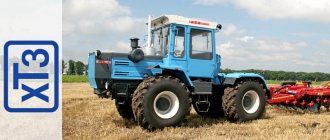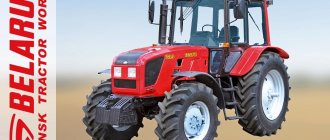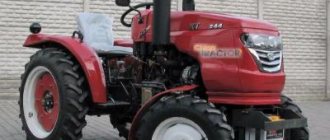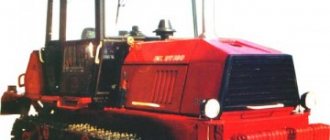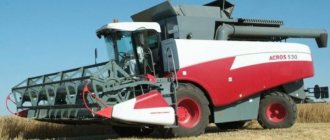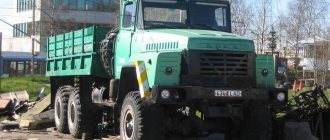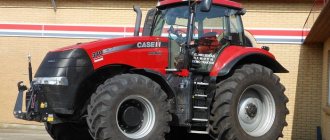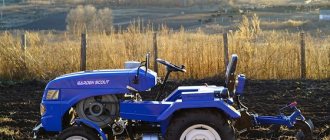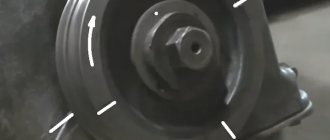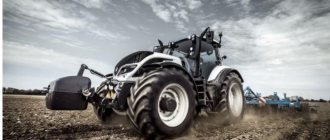The Kharkov plant is a leading manufacturer of wheeled and tracked tractors in Ukraine. During the Soviet era, the plant produced up to 70 thousand cars per year. The HTZ model range in 2022 includes wheeled vehicles based on the HTZ-150K, 242K and 243K models, tracked T-150 and HTZ-181, as well as the HTZ-3512 minitractor. The KhTZ-17221 and KhTZ 240K machines are being assembled in Russia. All KhTZ models are equipped with Russian and European diesel engines with a liquid cooling system.
HTZ-17221
The wheeled machine model 17221, considered a development of the 150K tractor, appeared on the market in 1997. A special feature of the tractor design is an articulated frame consisting of two halves. The connection is made on vertical and horizontal hinges. The design of the unit allows the movement of frame parts during movement. The maximum angle of deflection of the frame halves is 15° vertically and 30° horizontally.
The HTZ-17221 tractor, according to its technical characteristics, belongs to the traction category of 4.0 tons and is capable of working with trailed equipment weighing up to 20 tons. The first production machines were equipped with 180-horsepower 6-cylinder V-shaped diesel engines YaMZ-236. The use of diesel from a truck made it possible to reduce fuel consumption by 15%, reduce operating noise and exhaust smoke.
The tractors use a 4-speed gearbox with 16 forward speeds, providing speeds of up to 40 km/h. The use of hydraulic couplings allows you to switch speeds within ranges without interrupting the power flow. The capacity of the gearbox oil sump is 18 liters.
The box is equipped with a transfer gearbox for connecting the front axle drive. Front wheel drive can be switched off from the operator's cab. The transmission circuit has an interaxle differential mechanism that is activated automatically when wheel slip occurs. The wheel drives use planetary final drives, which provide increased traction.
The front axle of the tractor is mounted on longitudinal leaf springs equipped with additional telescopic shock absorbers. The rear axle is rigidly mounted on the frame. The machine is stopped by drum brakes located on the hubs of 4 wheels. The brake system drive is pneumatic. The distribution of forces is carried out by the pedal and the brake valve associated with it. Additionally, a band parking brake is installed, equipped with a pneumatic spring accumulator. The brake acts on the front axle drive shaft.
The tractor uses a hydraulic system with a common supply tank with a capacity of 85 liters. The hydraulics have several pumps serving various components. To operate the steering, a pump driven by the engine or tractor wheels is used. The second mode is used when towing a faulty vehicle.
The 17221-21 version of the tractor is distinguished by the installation of an 8-cylinder 240-horsepower YaMZ-238M2 diesel engine with increased torque. The fuel reserve is 430 liters, located in tanks on the sides of the operator's cabin.
The machine has a weight increased to 8.94 tons.
The gearbox has not undergone any changes. The PTO shank is brought back and is equipped with a replaceable pair of gears. Depending on the type of attachment, shafts of different diameters and with different numbers of splines are used.
The tractors are equipped with a 2-seater metal cabin equipped with a safety cage. In the standard version, the cabin is equipped with a ventilation unit with the ability to heat the air, a windshield cleaner, and two audio system speakers. It is possible to install an air conditioner. Depending on the modification, a cabin is used with the operator positioned on the right or in the center. The operator's seat has a spring support and is adjustable in height and distance from the pedals.
HTZ T-012
The production of small-sized equipment began at KhTZ in the late 80s. Unlike other factories that have mastered the production of walk-behind tractors, Kharkov residents took the path of creating mini tractors that provided increased productivity and had increased load capacity.
The HTZ-012 minitractor belongs to the 0.2 t towing class and is equipped with a 2-cylinder petrol engine model SK-12 with an air cooling system. The motor develops power up to 11 hp. With. and has a service life of 6 thousand hours before major overhaul. Engine starting is electric. The power system is equipped with an automatic adjustable speed controller, which ensures that the motor operates at a given mode. The T-012D modification, equipped with a 12.5-horsepower Perkins 103-06 diesel engine, was assembled in small batches.
The transmission included a clutch and a 4-speed gearbox. For reversing there were 2 gears. In the basic configuration, the tractor is equipped with 2 PTOs, driven forward and backward. Each shaft had a separate connection, which increased the operational parameters of the machine. The tractor cabin is open type, the steering column is tilt adjustable.
The production of cars continued for several years and stopped in the second half of the 90s. The KhTZ plant does not produce spare parts for mini tractors, so keeping the machine running is difficult. Many owners replace worn-out units with units from other equipment.
Engine
The minitractor received an air-cooled SK-12 carburetor engine with two cylinders.
This unit was produced in Kazakhstan. The power of the T-012 power plant at maximum speed was 11 “horses”. The manufacturer guaranteed reliable operation of the motor for 6,000 operating hours. After this, the engine was overhauled. The SK-12 small-displacement unit used in the Kharkov mini-tractor was equipped with an automatic regulator that controls and ensures the number of crankshaft revolutions within a given limit in the event of a load change to nominal values.
In some cases, shielding was installed on parts of the ignition system to eliminate radio interference. The SK-12 was additionally equipped with various elements at the request of the customer. The air entering the carburetor of the T-012 power plant was accelerated to the required speed in the nozzle. A vacuum was created in the narrow section, allowing fuel to enter the nozzle and atomizer, and then into the air flow. Fuel atomization and evaporation occurred. The mixture entered the engine intake valve through a pipe, and the power was regulated by the throttle valve.
Air cooling was used to lower the temperature of the cylinder walls. It prevented the grease on the walls from burning. Special filters were used to clean the T-012, and a regulator was used to control it. The SK-12 engine was started using an electric starter. The mini-tractor developed a forward speed of up to 15 km/h, and a backward speed of up to 4 km/h.
HTZ-7
A small-sized wheeled tractor with a traction class of 0.4 t, which was produced until 1956. Production began in 1950, at that time the machine was the only representative of small-sized tractors in the USSR. The design of the machine does not have a frame; all loads are taken by the engine crankcases and gearboxes. The front and rear axles are mounted rigidly, without suspension. The vehicle had the ability to adjust the track by reinstalling the wheel rims and final drive housings.
The liquid-cooled petrol power unit developed a power of 12 hp. With. and had 2 cylinders arranged vertically. The power supply system is carburetor. The ignition and lighting equipment worked from a magneto. The hydraulic system pump was located on the engine. The transmission is mechanical, equipped with a PTO located in the side of the crankcase. The shaft was equipped with a pulley for belt drive of mechanisms of trailed agricultural equipment.
The modernized version of the tractor received a 14-horsepower diesel engine and was produced under the designation DT-14 until the end of 1959.
Specifications
The special machine HTZ 7 has the following characteristics:
- Dimensions: length – 1310 mm, in the reduced version 1100 mm, track width – 1500 mm, in the reduced version – 1000 mm. Ground clearance – 52 and 31 cm, curb weight 1300 kg.
- Engine: the tractor is equipped with a gasoline 2-cylinder, four-stroke, carburetor power unit, volume 1.4 liters, power 12 hp. It is water cooled, the system is equipped with a thermostat, and an anti-air valve is equipped on the radiator cap. The pistons and rings were taken from a Pobeda car, the oil pump from a Moskvich car.
- Transmission: the equipment is equipped with a single-plate dry clutch, which has mechanical control and a split clutch with a final drive. Torque is transmitted to the reverse gearbox and side shaft, then to the differential and chassis gearbox. The tractor is equipped with a 5-speed gearbox, one of which is slow, designed for planting robots. Reverse gears have 4 gears; they are designed for working with attachments in reverse mode.
- Brakes: the braking system has two band brakes on the axle shafts of the drive wheels, thanks to which the tractor driver can make sharp turns.
- Hydraulic system: the equipment is equipped with hydraulics, with the help of which the tractor controls attachments and trailed devices.
Cabin on an open type tractor.
HTZ-16
An original example of military equipment produced in Kharkov at the initial stage of the Great Patriotic War. The vehicle was based on an STZ-3 agricultural tractor, with the hood and driver's cab removed. The 52 hp kerosene 4-cylinder engine remained unchanged. With. and a manual transmission with final drives.
An armored body of a welded structure, made of steel sheets with a thickness of 10-25 mm, was installed on the tractor chassis. The weight of the car was 7000 kg, so the chassis was equipped with amplifiers. To ensure smooth running, road wheels and tracks from STZ-5 were installed.
The vehicle's armament consisted of a 45 mm caliber 20K gun, mounted in place of the cockpit windshield. The gun did not have the ability to rotate horizontally; guidance was carried out by changing the direction of movement of the tractor. Additional armament was a 7.62 mm DP machine gun located inside the wheelhouse. The crew consisted of 2-4 people.
The KhTZ plant managed to produce at least 142 hulls for vehicles of this type, which took part in a number of battles in 1941. The last KhTZ-16 vehicles were lost in 1942 during the May battles for the liberation of Kharkov. The only surviving copy of the HTZ-16 is in the Museum of the Great Patriotic War in Kyiv.
History of appearance
Throughout -1932, a number of experiments were carried out in the Soviet Union to create self-propelled artillery units based on agricultural tractors for direct support of infantry. About a dozen different prototypes of armored tractors were tested. By the spring of 1932, the leadership of the Department of Motorization and Mechanization of the Red Army, having received the results of tests of armored tractors of various designs, came to the conclusion that it was impossible to make a full-fledged combat vehicle out of an ordinary tractor. The resulting equipment could not solve the assigned combat missions.
After a series of defeats suffered by the Red Army in the summer of 1941 and heavy losses in tanks, the Soviet leadership took a number of urgent measures. On July 20, 1941, based on the results of a meeting of the State Defense Committee of the USSR, Resolution No. 219 “On organizing the production of 2 thousand armored tractors” was adopted. In accordance with it, serial production of armored tractors was planned to be launched at two leading tractor manufacturing enterprises: the Kharkov Tractor Plant (KhTZ) and the Stalingrad Tractor Plant (STZ). Moreover, armored tractors were supposed to be a by-product: at the same time, preparations were underway at the factories for the production of tanks: medium T-34 at Stalingrad and light T-60 at Kharkov. The design bureau of the NATI tank department was assigned to develop the project. It was supposed to armor and arm the tractors with 45 mm tank guns and use them as self-propelled anti-tank guns.
At the beginning of August, NATI tested four experimental models of armored tractors with 45 mm guns built on the basis of 1TMV, STZ-3, SHTZ-NATI and STZ-5. For mass production, they chose an option based on the STZ-3; when armoring, the tractor chassis was strengthened, and for smooth running, rubber-coated rollers and tracks from the STZ-5 tractor were installed on it. The driver's cabin was dismantled, and an armored cabin with an armor thickness of 10-25 mm was installed in its place. The armored tractor was armed with a 45-mm 20K tank gun, model 1932/34/37. For close combat, the crew had a DP machine gun carried inside. The mounted gun had limited firing angles - in order to aim it at the target it was necessary to turn the entire tractor. When put into mass production, the vehicle received the index XT3-16 (sometimes referred to in documents as T-16 (KhTZ)).
Taking into account that STZ has already mastered the production of T-34 tanks, and at KhTZ work has just begun to prepare for the production of T-60, People's Commissar of the Tank Industry V.A.
Malyshev decided to deploy the main production of armored tractors in Kharkov. The plan provided for the production of about a thousand KhTZ-16 by October 1941 at the Kharkov Tractor Plant, and another 500 in Stalingrad
The armored parts for them were to be supplied by the Novokramatorsk Machine-Building Plant. The latter, in turn, received rentals from the Mariupol plant named after Ilyich. Production of armored tractors began at the end of August 1941, but due to constant failures with components, it never reached the large-scale level.
In mid-September 1941, after the defeat and encirclement of the main group of the Southwestern Front near Kiev, there was a threat of rapid capture by German troops of Donbass and the Kharkov industrial region, where the main production capacities of metallurgy and heavy industry in the European part of the USSR were concentrated. Within a few days, the State Defense Committee of the USSR decided to evacuate hundreds of leading enterprises in Eastern Ukraine. By the time the Novokramatorsky plant was evacuated, it had managed to deliver no more than a hundred armored kits for tractors to Kharkov, while KhTZ had already prepared more than 800 tractor tracked chassis for the KhT3-16.
On September 18, 1941, the evacuation of the workshops of the Kharkov Tractor Plant began. In total, during this time, 142 armored tractors were built in Kharkov. Contrary to popular belief, STZ did not assemble armored tractors at all, as it was busy with the production of T-34 and STZ-5-NATI tractors.
Important Everything you need to know about potato diggers for walk-behind tractors: homemade drawing, video
HTZ-121
A wheeled tractor for agricultural purposes, used for work with increased requirements for tractor power. Serial production of the vehicle with a towing class of 3.0 tons began in 1993.
The power unit is a 4-cylinder diesel engine SMD-19T with a displacement of 6.3 liters. The engine is equipped with a supercharging system with intermediate cooling of compressed air. Depending on the degree of boost and fuel equipment, the engine develops a power of 120-145 hp. With.
The transmission uses a clutch with 2 discs and a separate output for PTO drive. The gearbox is mechanical, with several ranges and a transfer gearbox designed to transmit torque to the front and rear axles. The front axle is equipped with a balancer suspension, the rear axle is mounted motionless on the frame.
Tractor Vladimirets 2032
The machine is used to perform light work in areas with limited space. Small dimensions allow the model to be used in gardening, vineyards, livestock farms, etc.
Depending on additional equipment, the machine can be used in the following areas:
- Agriculture. Plows, soil cultivators, harrows and other soil cultivation equipment are used. The machine is widely used in farms with limited space;
- Utility services. The tractor is equipped with a front blade, brushes, etc. This allows you to clean the asphalt surface from debris and snow;
- Construction. The machine is used for transporting construction materials;
- Animal husbandry. Using a trailer allows you to transport feed and other cargo.
The Vladimir tractor 2032 is available in two modifications. The all-wheel drive version is designated 2032A. Depending on the version, the tractor has the following dimensions and weight:
- The length of the machine with front and rear tow hitch is from 3180 to 3320 mm;
- Width along the outer edges of the wheels – from 1560 to 1660 mm;
- Height from the covering to the edge of the exhaust pipe – from 2540 to 2570 mm;
- Base (distance between axles) – 1775 mm;
- Ground clearance under the rear axle – 345 mm;
- The track at the wheel centers is adjustable;
- Tractor weight is from 2000 to 2390 kilograms.
Important Technical characteristics of the Virax mower and its main modifications: price, reviews, video
The model's power plant has two working cylinders. The motor is air-cooled. The maximum engine power is 30 horsepower. This is enough to perform a wide range of light work.
IMPORTANT: Modification 2032A is equipped with two drive axles. The rear axle works constantly, the front axle is connected
The bridges are equipped with wheels with all-terrain tires.
HTZ-150
The T-150 tracked tractor belongs to the class of machines with a traction force of 3.0 tons. The machine has a wheeled version under the designation HTZ T-150 K, which differs in a number of components. Wheeled vehicles use a different chassis, control system, frame, and transmission units. At the same time, some transmission units are unified. Tracked vehicles are produced in two modifications - bulldozer and agricultural tractor.
The machine is based on a riveted frame, consisting of 2 longitudinal channels and transverse reinforcements. The chassis consists of 4 road wheels per side. The rollers are located in pairs on carriages of a balancing structure with a spring suspension. The drive wheel is mounted at the rear and has 13 teeth for lantern engagement with the track. The tension of the caterpillar mover is carried out by a guide wheel mounted on the crank axle.
Tractors 150 and 150K were equipped with different engines. Initially, the T-150 used the original V-shaped 6-cylinder diesel engine SMD-60. Thanks to the use of a turbocharger, the engine develops a power of 150 hp. With. For starting, a P-350 gasoline starter with a cylinder volume of 0.35 liters is used. In connection with the cessation of production of the SMD-60 engine, the YaMZ-236D3 engine, similar in design, began to be used on the T-150 and 150K tractors. The engine is not supercharged and develops a power of 175 hp. With. and is equipped with an electric starter starting system.
The box has 3 ranges for forward travel and 1 for reverse. Each range consists of 3 speeds that switch without interrupting the power flow. For this purpose, on-board hydraulic couplings with a spool valve are used. The gearbox hydraulics operate from a separate pump installed inside the crankcase.
HTZ-150 machines are optionally equipped with an autonomous engine heater and air conditioning in the operator’s cabin. The cabin is 2-seater, has a safety cage, all metal construction.
Model range overview
The plant produces many wheeled and tracked models, let's look at the existing options:
- HTZ-7
- HTZ T-012
- HTZ-DT20
- HTZ-T25
- HTZ-T74
- XT-121
- HTZ T-150
- HTZ-T150K
- HTZ-181
- HTZ-240K
- HTZ-242K
- HTZ-243
- HTZ-243K
- HTZ-1721
- HTZ-2511
- HTZ-3512
- HTZ-5020
- HTZ-3522
- HTZ-16131
- HTZ-17221
- SHTZ-NATI
We invite you to familiarize yourself with the characteristics of the presented modifications of tractor machines from the Kharkov plant.
HTZ-7
The first compact frameless tractor of the USSR, on which pneumatic wheels and a mounted hydraulic system were installed for the first time.
Tractor HTZ-7
Its weight was only 1400 kg, the performance of the power plant was 12 hp. The car was equipped with a two-satellite differential.
Characteristics
| Power | 12 hp |
| Engine capacity | 1.32l |
| Fuel consumption | 280 g/kWh |
| Load capacity | 0.45t |
| Weight | 1.4t |
HTZ T-012
A reliable, safe tractor that is easy to operate and safe. Its performance is 11 hp, while the fuel tank capacity is 21 liters.
Tractor HTZ-012
HTZ DT-20
The tractor power was 18 hp. It was distinguished by high performance characteristics. Its serial production was suspended in 1969.
Tractor DT-20
HTZ T-25
Serial production of this model lasted about 5 years. The machine has gained great popularity due to its excellent maneuverability, ease of use, and reliability of all components. A special feature of this model were pneumatic wheels - the wheels installed at the rear had a larger diameter, and those at the front had a smaller diameter.
Tractor T-25
Engine performance was 25 hp. The front axle is balanced. Fast braking was provided by band-type brakes. A rigid suspension is installed.
HTZ T-74
A very successful modification, it was distinguished by increased reliability and versatility, rarely failed, and was produced in 5 variations. Out of production in 1984.
Tractor T-74
The tractor was actively used both for various agricultural work and for a wide range of road, construction and transport work.
HTZ-121
A very successful design, characterized by increased maneuverability, reliability of all components and mechanisms, and high maneuverability. The machine was able to overcome any obstacles, had high wear resistance, maintainability and high performance indicators.
Tractor HTZ-121In addition, it has very simple controls. The unit was equipped with an SND-23 engine with an electric starter with a capacity of 145 hp. With. The car could reach speeds of more than 30 km/h.
HTZ T-150K
This model belongs to the 3rd traction class. Her weight is 8200 kg. A diesel power plant with a capacity of 128.7 hp is installed.
Tractor T-150K
The cabin is perfectly sealed, with built-in heating and ventilation systems that increase operator comfort at any time of the year.
HTZ-181
The tractor with a caterpillar propulsion device, belonging to the 5.0 t traction class, is equipped with a V-shaped diesel engine YaMZ-238KM2, developing a power of 190 hp. With. Starting is performed by an electric starter, operating voltage is 24 V. An optional coolant and oil heater is installed to facilitate starting at low temperatures.
The chassis consists of 5 road wheels. Carriages equipped with spring suspension are installed at the front and rear. Each carriage consists of 2 balancers and is designed to accommodate 2 wheels. Between the carriages there is an additional roller with torsion bar suspension. The drive sprocket is located at the rear. To adjust the track tension, a guide wheel mounted on a special hydraulic mechanism is used. The idler wheel has a shock absorber that prevents shock loads from being transferred to the frame.
The HTZ-181 machine is superior to the T-150 in terms of technical characteristics and cabin ergonomics. The tractor uses a mechanical 3-range gearbox and a 1-disc clutch with a pneumatic drive. Each range provides 3 speeds. The maximum forward speed is 15.3 km/h, reverse – 7.9 km/h. The box uses hydraulic clutches that allow you to change speeds within the same range without interrupting the power flow. The range switch is equipped with a system to prevent the engine from starting when the gear is engaged.
The tractor is equipped with a hydraulic system with connections for connecting additional equipment. A gear pump with a capacity of 80 l/min is used to operate the hydraulics. At the rear of the machine there is a hitch, a rigid hitch (automatic hitch on request) and a PTO. The hydraulic drive of the hitch is from a separate gear pump, activated from the cab.
The PTO has a replaceable pair of gears, thanks to which you can set the rotation speed to 540 or 1000 rpm. The shaft shank is replaceable and differs in diameter and number of splines. The PTO is engaged using a hydraulic clutch. A special feature of the shaft on the T-181 is the ability to transmit full engine power. The tractor has space for installing a balancing weight weighing up to 442 kg. The load can be placed at the front or rear of the machine.
The operator's cabin is 2-door, equipped with a heating and ventilation system. At the customer's request, it is possible to install an air conditioner. The tractor is controlled by pedals and a steering wheel, which disengages the on-board hydraulic clutches.
HTZ-240K
A wheeled tractor with a thrust of up to 6.0 tons and a load capacity of 20 tons. The dead weight of the machine (filled with fuel and operating fluids) is 8.37 tons. The tractor is equipped with a closed cabin with a microclimate system. To increase cross-country ability, it is possible to install dual wheels.
The tractor is equipped with several types of diesel engines. Upon special order, the engines are equipped with a gas-diesel power system designed for use as compressed natural gas fuel. The equipment allows reducing fuel consumption by 60%.
Tractors use a mechanical range transmission, which ensures gear shifting within the range without interrupting the flow of torque. The box has 4 ranges for forward movement and 2 for reverse. The box provides 16 forward gears and 8 reverse gears. A 2-speed PTO is installed on the back cover of the box, allowing you to work with Russian and foreign-made attachments.
The T-240K uses a hydraulic system with a multi-sectional distribution panel and an enlarged supply tank. Hydraulics make it possible to use several actuators with parallel operating modes in a mounted system. The automatic switchgear monitors oil consumption in each drive.
HTZ-243
The machine with the designation KhTZ-243 K is a modification of the 240K model tractor, equipped with a 250-horsepower YaMZ-536 engine with a Common Rail fuel supply system. The diesel engine has reduced fuel consumption and meets Stage IIIA environmental standards. The tractor transmission has no changes.
Description of machine parameters:
- traction force - up to 60 kN;
- hitch load capacity - 5000 kgf;
- ground clearance - 400 mm;
- curb weight - 8450 kg;
- turning radius - 6.7 m.
HTZ-3512
A universal small-class wheeled tractor with a traction force of 0.6 tons, equipped with a 3-cylinder diesel engine MMZ-3LD-22. The 6-speed gearbox, with 2 additional reduction gears, provides travel speeds in the range of 1.37-30.25 km/h. The front wheels have no drive and are controlled by a mechanical gearbox (worm and roller). The mounted system is equipped with a hydraulic drive and a single-speed PTO.
The machine is intended for use on small farms and when performing work in cramped conditions. The turning radius is about 3.5 m. The cabin is designed for 1 person, equipped with a ventilation and heating system, and a windshield wiper. The steering column and seat are adjustable.
HTZ-16131
A wheeled tractor belonging to the 3.0 t traction class. The machine is based on the 150K model, but has a solid frame with solid side members. The front drive axle is equipped with a balancer suspension and is attached to the frame using brackets, the rear axle is mounted rigidly.
The basic version of the tractor is equipped with a 6-cylinder Deutz diesel engine developing 170 hp. With. The KhTZ-16331 modification is distinguished by the installation of a V-shaped 8-cylinder 180-horsepower KamAZ-740.02 diesel engine. There are no differences between the machines in other parameters. The technical characteristics of the engines allow the tractors to be used for various agricultural work, as well as tractors. The permissible trailer weight is 15 tons.
The hydraulic steering and linkage system has a common circuit powered by a single pump and tank. To control the hitch, 2 distributors are used. The range 16-speed gearbox is equipped with a single-speed rear-mounted PTO. An additional shaft with an independent drive is located on the front beam. The shaft is driven from a pulley on the engine crankshaft.
Tractor maintenance
For normal operation of the tractor, it is necessary to carry out timely maintenance and servicing of the equipment:
- replacing engine oil and oil filter;
- changing transmission oil;
- adjusting the alternator belt;
- cleaning the air fuel filter, as well as cleaning the filter element in the hydraulic system;
- checking the tightness of all bolts and nuts on the machine, especially on the steering;
- checking clearances in the chassis;
- checking the electrolyte in the battery;
- checking tire pressure;
- replacing coolant.
Equipment maintenance is a mandatory procedure that will keep the equipment in good condition.
HTZ-17021
A wheeled vehicle of traction category 3.0 t with a drive on 2 axles is equipped with a sectional frame with an articulated joint. The scope of application is heavy agricultural and transport work. The machine is capable of working with a semi-trailer weighing up to 20 tons at a speed of up to 40 km/h.
The power unit is a 6-cylinder 170-horsepower Deutz BF6M1013E diesel engine. The diesel engine is equipped with a dry clutch with 1 disc. The gearbox is range, has 12 gears for forward and 4 for reverse. The box contains a fuse for starting the engine when the speed is on. The front axle of the tractor is mounted on a spring suspension with additional shock absorbers, the rear axle is rigidly fixed to the frame section. The machine is equipped with a center differential with automatic locking.
The cabin is designed for 2 people, equipped with a microclimate system (optional) and a power safety cage. The machine uses an automatic control of operating modes of attachments, which reduces fuel consumption and increases productivity. To drive the hitch there is a 2-speed PTO.
Briefly about the history of the MTZ model range. Major milestones
Minsk Tractor Plant is one of the largest agricultural engineering enterprises not only in the post-Soviet space, but throughout the world. Today it is a powerful engineering holding, which, in addition to the enterprise in Minsk itself, includes eight more Belarusian ones that are sold in more than 60 countries around the world, and assembly plants are deployed in Russia, Ukraine, Kazakhstan, Kyrgyzstan, Tajikistan, Uzbekistan, Azerbaijan, Lithuania, Romania, Hungary, Serbia, Cambodia, Egypt and Venezuela.
The Minsk Tractor Plant gradually moved towards the production of tractors of all main traction classes and application possibilities. Founded on May 29, 1946, the company initially produced KD-35 tracked tractors and KT-12 and KT-12A skidders. The first production wheeled tractors rolled off the plant's assembly line on October 14, 1953. These were “MTZ-1” and “MTZ-2” weighing 3.28 tons and producing 37 hp. - the founders of the now famous trademark “Belarus” (“Belarus”).
“MTZ-2” was intended for inter-row cultivation of low-stemmed crops and had a matching track of the front and rear wheels; and “MTZ-1” – for processing tall crops (corn, sunflower), with front wheels close together.
Until 1957, wheeled tractors were produced at MTZ in parallel with tracked ones. The plant supplied the country with new skidders of its own design, TDT-40 and TDT-54. Subsequently, their production was transferred to Altai and Karelia.
The result of a radical modernization of the first Belarus wheeled tractors, taking into account the experience of their operation and new technical solutions, was the launch of mass production of the MTZ-5 (1956) and MTZ-7 (1959) families. These tractors were much more modern than their predecessors, stronger and more efficient in terms of fuel efficiency and material consumption, reliability and service life of the machine.
Until the early 60s, the Minsk Tractor Plant had production facilities allowing it to produce 18 thousand wheeled tractors per year. By 1965, as a result of large-scale reconstruction, this number was increased to 65 thousand. In the early 60s, a new advanced model of a universal row-crop tractor of 1.4 traction class - "MTZ-50", as well as its all-wheel drive 4x4 modification "MTZ-52" was launched into production. On a vacant site not far from MTZ, construction began on the Minsk Motor Plant, with a production capacity of 120 thousand D-50 diesel engines per year. The Belarus MTZ-50 family of tractors found its application in all spheres of the national economy and was produced in Minsk until 1985.
Important Which electric cultivator is best to choose for your garden and garden?
A workshop at the Minsk Tractor Plant through the eyes of a correspondent for the American Life magazine. 1960
However, the real bestseller among the products of the Minsk Tractor Plant was developed by 1972 on the basis of the MTZ-50. In addition to increasing the power of the serial engine, a significant number of changes and improvements were made to the design of this tractor. Since 1974, MTZ-80 has become the main model of the plant, the basis for a whole family of universal row-crop tractors and the most popular tractor in world history. At the same time, its all-wheel drive version, the MTZ-82, began to be produced as the main model.
Over the years of production, this tractor has changed, modernized, and “kept up with the times.” Until now, the Minsk Tractor Plant has been successfully selling in the CIS and abroad tractors developed on the basis of the MTZ-80, adapted to solve a wide variety of problems in agriculture and municipal services, in construction and the transport sector.
When developing foreign markets, the Minsk Tractor Plant was the first among tractor manufacturers in the CIS to fully certify all manufactured tractors for compliance with European Union standards, receiving in early May 2000 a certificate of conformity of the quality system according to ISO-9001 for the design and production of tractors. The total number of tractors produced over the years of the plant’s operation is close to four million. Every tenth tractor in the world is a MTZ product!
Attachments
KhTZ tractors can work with universal mounted equipment of Russian and foreign production, these are:
- plow with several shares;
- agricultural equipment for sowing, care and harvesting;
- trailer with a carrying capacity of 15-20 tons.
The HTZ tractor model 17221 is equipped from the factory with a bulldozer blade with adjustable position in the vertical plane. The angle of attack has 2 fixed positions, which can be adjusted manually. The bulldozer blade can be installed from the factory on other models.
Owner reviews
Paying tribute to the performance characteristics of imported tractors, I prefer to update my machine park with domestic developments. I consider it a success to purchase a powerful and easy-to-maintain wheeled station wagon HTZ model 16331. The products of the Kharkov plant cannot be called perfect, however, with qualified maintenance, all equipment produces all assigned and operational resources with a guaranteed one and a half reserve. Arkady Vasilievich
A situation arose when both my MTZ and T-70 tractors failed at the most crucial moment in the midst of plowing for winter grain. The situation was saved by a short-term rental of the HTZ-16131 tractor, which coped with a large amount of work in two incomplete days. The machine surprised us with its high productivity, economical fuel consumption, modern design and cabin comfort, and the compatibility of the attachment with wide-cut agricultural machines of older models. In my opinion, this model has good prospects for the future. Victor
Advantages and disadvantages
Owners of cars from the Kharkov plant note a number of advantages:
- the ability to move wheeled mechanisms on public roads;
- the use of wheels of the same diameter improves weight distribution and increases load capacity;
- easy access to components for repairs;
- the use of YaMZ and KamAZ diesel engines simplifies the search for spare parts;
- the ability to work with attachments from other brands of equipment;
- reliability of the design (with the exception of a few models).
Negative aspects of HTZ technology:
- the need for frequent oil changes in engines and transmission units;
- low quality hydraulic hoses;
- noisy cabins without thermal insulation;
- breakdowns of gearboxes on cars 3512 and 17221.
User manual
This document must be studied immediately after purchasing a VTZ wheeled tractor. The instructions contain the following useful information:
- Design of the VTZ wheeled tractor;
- Technical characteristics of a specific model;
- Running in the engine;
- Tractor machine maintenance;
- List of problems and recommendations for eliminating them.
Let's take a closer look at some sections.
Run-in
The machine is run in for 8 hours and begins without loads, then the loads are gradually increased and brought to the maximum value.
The purpose of break-in is to ensure that the moving parts of the engine, gearbox, etc. are ground in in order to extend the service life of the unit.
During the running-in period, all systems of the VTZ tractor are checked. At the end of the procedure, it is necessary to completely change the oil in the engine and gearboxes of the tractor.
Maintenance
Let's list a few important points that will help the owner of a VTZ tractor provide the machine with proper care:
- Timely cleaning of dirt and lubrication of tractor components.
- Change the engine oil after every 100 operating hours. It is recommended to use SAE 10W-40 or API engine oil.
- Change the transmission oil every 1000 operating hours. API GL-5, SAE 85W-90 recommended.
- Monitor the quality of fuel and oil consumed by the tractor.
- When preserving the unit, it is necessary to drain the working fluids.
Basic problems and solutions
A complete list of faults is indicated in the manual; we list the reasons that prevent the VTZ tractor from starting the engine:
- Poor quality diesel fuel or oil has been filled.
- The oil level in the engine crankcase is below normal.
- The fuel tank has run out.
- The filtration system is clogged or damaged.
- The injection pump does not pump fuel.
- Problems with the electric starter or battery (discharged).
